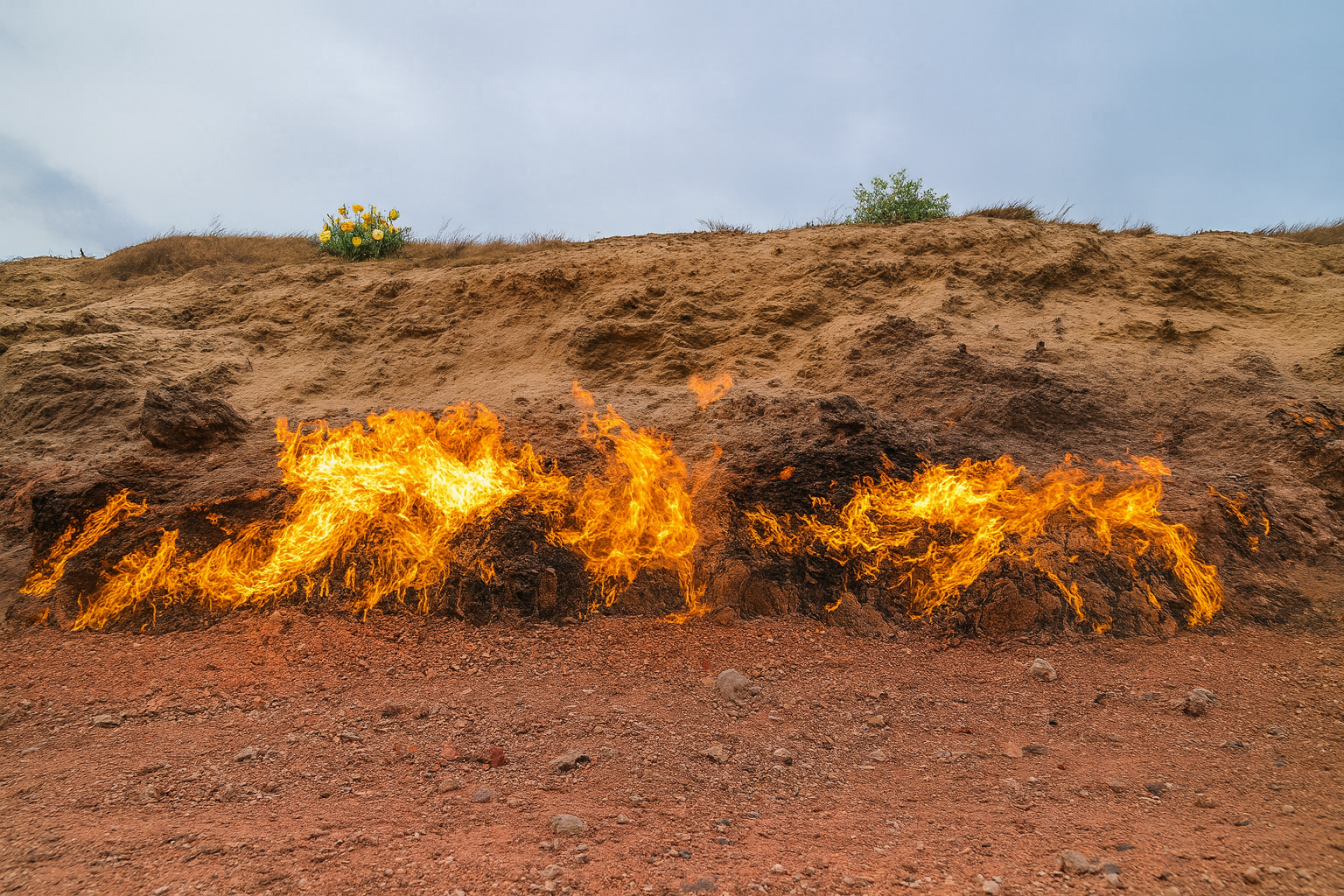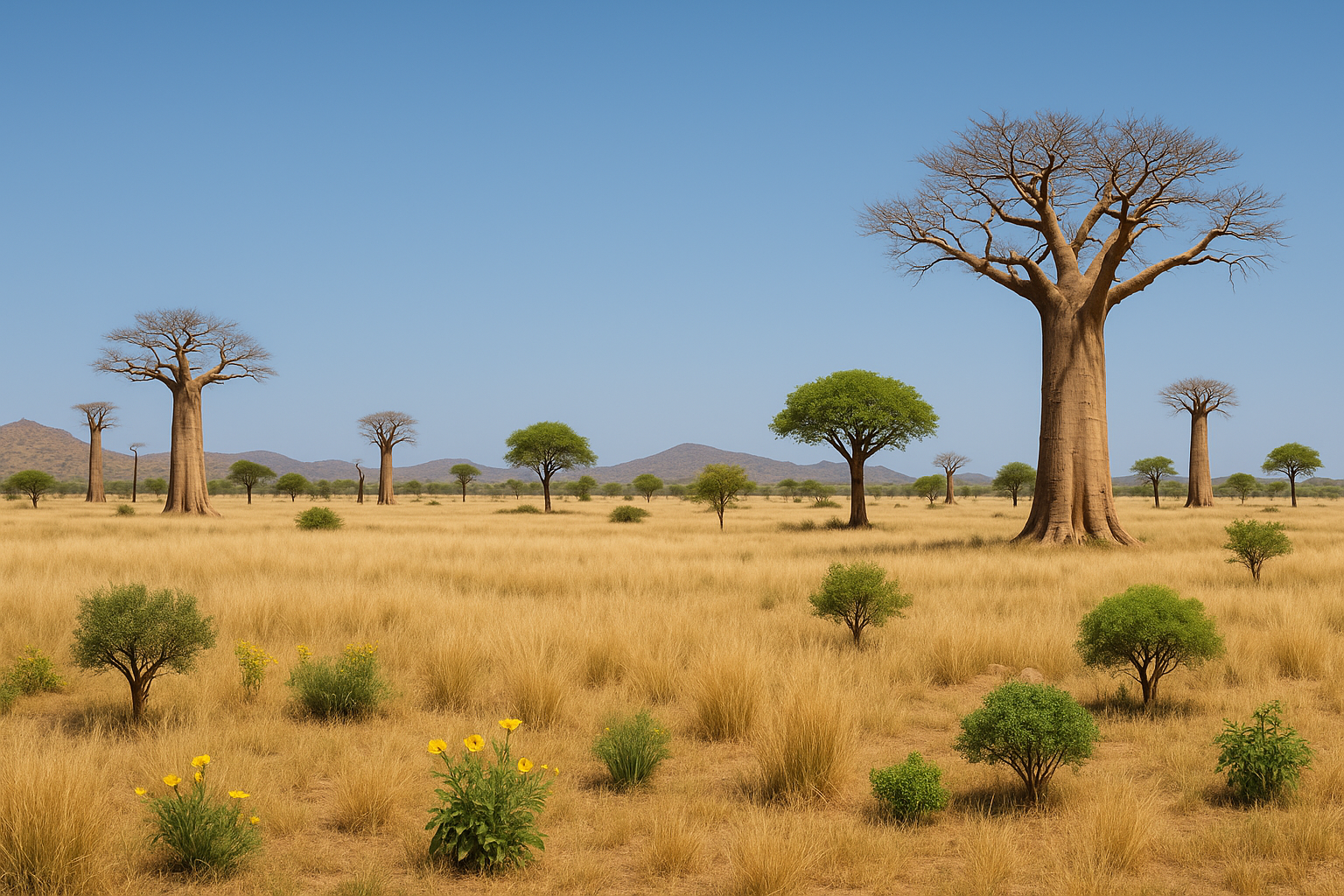Urtzan Plains
Geography
Natural Gas Reserves
The region is rich in natural gas deposits. The gas seeps through cracks in the earth and is ignited by spontaneous combustion, creating the continuous fire. The fire has been burning for several decades, if not longer.
Endless Savanna and Grasslands
The majority of Urtz’s terrain is made up of wide, open savannas and undulating grasslands, with tall, golden grasses swaying gently in the dry winds. These vast plains are interrupted by seasonal rivers and shallow, often cracked, salt pans. The flora here is sparse but resilient—thorny acacia trees and hardy shrubs dot the landscape, and the occasional baobab or giant cycads rise from the horizon like sentinels.
Oases and Hidden Wetlands
Scattered across Urtz, often in the most unexpected locations, are hidden oases—lush pockets of life surrounded by parched earth. These oases, fed by underground springs or hidden aquifers, are crucial for the survival of the region’s flora and fauna. Tall reeds, date palms, and creeping vines cluster around the small, clear water sources, providing sustenance to a variety of creatures that have adapted to the harsh landscape.
Region 1
The region which borders the Great Desert, is the most arid part of the country. It is characterized by flat plains, occasional sand dunes, and rocky ridges. The soil in this region tends to be sandy, and erosion can be a concern, particularly during the dry season when winds can sweep across the landscape.
Region 2
The region closer to Camille is more varied, with gently rolling plateaus and hills made up of granite and volcanic rocks. This region has better vegetation compared to the one bordering the Great Desert, but still experiences significant dry periods.
Climate
Eternal Sunlight
Like the rest of the sun side, Urtz is perpetually lit. However, the angle and atmospheric density soften the glare compared to central Naess.
Thermal Stratification
With volcanic vents, burning gas fields, and baked savanna plains, Urtz radiates heat from above and below. This results in frequent low-altitude turbulence, especially during calm periods.
Volcanic Wind Belts
- The volcanic zone of Region 2 creates updrafts as hot gases and air rise through fractured earth, fuelling warm, dry katabatic winds.
- These thermal winds can whip across the savanna without warning, carrying ash or embers, and sometimes triggering wildfires in the tall grass.
Savanna Whirls
- During periods when both moons align, low-pressure systems form over the grasslands, giving rise to grass twisters—fast-moving, narrow funnels of wind that suck up dry vegetation and scatter sparks from the eternal flames.
- Locals call these “fire dancers”, and some are strong enough to create minor burn scars or threaten isolated structures.
Ash Haze Events
- Micro-eruptions or subterranean gas combustions can inject fine ash into the lower atmosphere, resulting in greyish haze layers that persist for days.
- These episodes slightly lower surface temperatures and can affect breathing for wildlife and travellers, especially in Region 2’s volcanic hill zones.
Skyfire Nights (a misnomer – it occurs in constant daylight)
During large seismic events, gas burns in ribbon-like waves across the plains. The sky seems to flicker with flame, though it is actually a heat distortion effect enhanced by ash in the atmosphere.
The Howl Season
Once per long moon cycle, wind passes through lava tubes and narrow rock formations in Region 2, generating a low, continuous howling resonance that can last for days. Animals become restless, and some locals report dream disturbances.
Ashfall Mirage Days
When thin ash clouds combine with high heat near the Mirage Fields of Meda, Urtz may experience a false dusk — a moment when the light dims, temperatures drop briefly, and shadows stretch oddly across the plains.
Moon Effects on Weather
- Short Moon Rise: Known locally as “Whisper Wind” time — shallow evening-like breezes pick up over the plains, causing rumbling ground sounds due to gas surges. Grazing animals respond with extreme caution; some predict volcanic eruptions from changes in animal behaviour.
- Long Moon Overhead: Causes subtle seismic tension in the crust, which may increase gas pressure and trigger new fires or spontaneous ground fissures that smoulder for days.
Regional Weather Breakdown
Region 1 – Northern Desert Borderlands
- Hottest and driest part of Urtz.
- Receives dry convection winds from Masozi and Naess, often carrying sand and desert heat.
- Salt pans expand during drought cycles; flash storms can cause alkaline flooding that evaporates into white crusts.
Region 2 – Volcanic Uplands and Gas Fields
- Hot, unstable, with bursts of vent heat and spontaneous ground fires.
- Weather is unpredictable — dry one moment, then shaken by a thermal storm the next.
- Volcanic ash clouds can drift slowly over grasslands, reducing visibility and generating blood-red sunsets in the always-daylight sky.






Comments